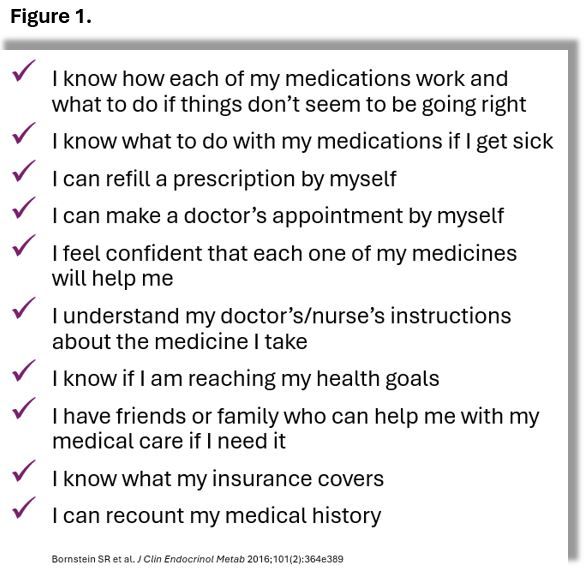Treating Congenital Adrenal Hyperplasia: Challenges in the Transition to Adult Care
In young adults with congenital adrenal hyperplasia of age to transition to adult care, 25% to 50% are not successful. Here are thoughts on problems and solutions.
The transition period from pediatric to adult care for individuals with congenital adrenal hyperplasia (CAH) can be a time of significant anxiety and confusion, a passage made more complex as it occurs before full emotional maturity during late adolescence. The barriers to and challenges around the successful transition are both general, relevant to shifts in care location for young adults without chronic health conditions, and also highly specific to the ongoing needs of those with CAH.
©Monkey Business/stock.adobe.com

Research focused on this young population has found that between 25%1 and 50%2 who reach the transition do not attend follow-up care after transfer to an adult setting.
Issues in Adolescence
The priorities of CAH medical intervention and disease management in adolescence begin to shift from physical growth and development to preservation of long-term adult health, prevention of infertility, and optimizing quality of life.3-5 Youth at this stage most often are beginning to assume greater responsibility for managing CAH vs full reliance on parents or other caregivers, presenting a critical period for increasing education on the disease and its management. 3-7
At the same time, puberty drives hormonal changes, including insulin resistance, increased androgen production and increased cortisol clearance that can make CAH control more difficult.6-8 In addition, once full growth is achieved in later adolescence, it is not uncommon to switch treatment from hydrocortisone, the standard of care in pediatrics and dosed 3 times a day, to longer-acting glucocorticoid (GC) formulations, which follow a once- or twice-daily dosing regimen. As adolescents and young adults become more active, the 3-times-a-day hydrocortisone schedule can become problematic, introducing medication adherence as an additional complication to CAH disease management as the transition to adult care grows closer.3-8
Adherence may become problematic for a host of other reasons, including for young men who are at particular risk for confusion about the implications of stopping treatment, given they are fully “virilized.2,4 Young women often become concerned with highly visible medication- and CAH-related weight gain and potentially by hyperandrogenism and hirsutism as well as menstrual irregularities—each and all presenting potential barriers to prescribed treatment.2,4,7
The vulnerability of youth at this stage of life with CAH requires a level and intensity of care that clinical guidelines suggest is best offered in a coordinated manner by a multidisciplinary team, preferably in a multidisciplinary setting.3 Guidelines also recommend that transition begin “several years prior to dismissal from pediatric endocrinology,”3 guidance echoed by numerous investigators.1,2,6-9 Ideally the gradual transfer of care would allow consolidation of the relationship with the adult physician before the individual ends care with the pediatric endocrinologist, typically after age 18 years. “At this juncture, patients should be reminded of the importance of continued GC treatment,” guidelines from the Endocrine Society state.3 A more urgent call to action comes from Gerard S Conway, professor of medicine at the Institute for Women’s Health, University College London, who wrote: “The transition period affords the young adult an opportunity for an educational review of CAH that may never arise again so conveniently and will be beneficial for optimising their well-being as adults.”9
Models for Transition
There are no controlled studies of how to transfer individuals with CAH from pediatric to adult care. A gradual progression with a structured approach, psychological support, and information sharing is central to all transitional care.8 More specific to the shift for young people with CAH is tailored education regarding genetic testing, surgical history, medical disease management, stress dosing, emergency care, matters of sexuality and fertility, and preventable long-term comorbidities such as obesity, cardiovascular disease, and bone health.1,9-12
A summary of the most critical elements around transition cited in the literature includes1-3,9-12:
- Multidisciplinary transition clinics involving pediatric and adult endocrinologists, gynecologists, urologists, and psychologists to support good medical adherence among adults with CAH
- Reassessment of treatment regimens that ensures uninterrupted glucocorticoid and mineralocorticoid administration as well as that regimens are adapted to recommendations for adult CAH
- Gynecologic evaluation for all adolescent females, particularly where menstrual flow is blocked and in anticipation of penetrative vaginal intercourse or desired pregnancy
- Testicular ultrasound for young men upon completion of puberty followed by regular examination for testicular adrenal rest tumors (TARTS)
- Counseling on the role of continued adherence to medication in supporting fertility for both men and women
- Psychosexual and genetic counseling
Several models of transfer from pediatric to adult care to support a successful transition are cited frequently in the literature. The shared or “combined” approach, introduces the adolescent or young adult to the adult provider while still receiving care in the pediatric system in a joint meeting.3,12 In the Endocrinology Transition clinic model pediatric and adult clinicians share clinical consultation for a transitional period.2,12 In CAH this model has had mixed results. Gleeson et al found the combined transition approach did not increase engagement in adult care.2 Twito and colleagues, however, in a study of overlapping care adherence, reported follow up in the adult clinic higher than 80% and not linked to age at care transition.12 Satisfaction with the model was also high (86.8%) and, importantly, was higher among participants who were adherent to follow-up.12 A “hub and spoke” model has also been evaluated, with specialists working in tandem with secondary care clinicians, to better engage adults with CAH within the care system.2

Another study evaluated readiness for care transition among youth with CAH and the impact of transition on adult medication adherence. Ekbon and colleagues11 used a CAH-specific questionnaire based on the Endocrine Society clinical practice guideline published in 2016.13 The questions (Figure 1) focus on disease knowledge, self-care, medications, health service, prescriptions, and navigation of the health care system.11 Like Twito, Ekbon reported positive findings, with more than two-thirds of study participants indicating “good readiness” for transition. Medication adherence was also classified as “good” in 61% of participants and those with good transition readiness had higher adherence to current medication regimens (53%). Subsequent follow-up visits in adult care within 1 to 2 years, a measure of a successful transition, were also relatively high in this study.11
Unavoidably, logistical failures may play a role in unsuccessful transfer and transition. When a 25% dropout rate during transfer from pediatric to adult tertiary endocrine care in a large center was scrutinized, nearly two-thirds of the loss could be attributed to failure of practical logistical steps that included breakdowns in communication between pediatric and adult specialists.1 When the investigators evaluated key transition success indicators Davidse et al1 found that one-quarter of the participants in this study did not present at the first adult care visit, an outcome known to be significantly associated with future attendance and that approximately 40% missed 1 or more subsequent appointments in adult care; most of that group did not return and were lost to followup.1
Potential for success
A quality improvement initiative at the University of Alabama Birmingham8 evaluated the feasibility of introducing an evidence-based health care transition program for adolescents with CAH that is based on combining CAH care guidelines3 and the Got Transition Six Core Elements of Healthcare Transition14approach. The 6 core elements trace a multilevel multidisciplinary sequence of events germane to transition for all youth with chronic conditions14:
- Development of a transition and care policy or guide
- Tracking and monitoring using established criteria to identify appropriate youth
- Transition readiness assessments followed with education targeting knowledge gaps
- Transition planning- including preparing youth and parents for an adult approach to care,
- Transfer of care
- Transfer completion, including regular follow-up with adult primary and specialty care clinicians.
As adapted for transition of youth with CAH by UAB researchers, the Comprehensive Adolescent Healthcare Transition (CAH-T) program is initiated at age 12 years and ends between ages 18 and 21.8 As the summary to follow illustrates, the program incorporates all of the clinical, educational and, importantly, the logistical elements deemed essential to success.8
The Bottom Line
No single approach to transition will be suitable for all situations or all individuals and their families. As Dennis and UAB colleagues point out, “proximity and availability of specialty care providers is often a limitation.”8 Lower socioeconomic status also correlates with greater odds of not attending adult care, they noted.8 Young adults whose understanding of CAH pathophysiology is poor are likely to struggle with transition, underscoring the essential role of education, assessment, remediation, and reassessment of knowledge gaps over time.14 Assessment of the ability and willingness of youth to engage in self-care and of parental/caregiver support for the young adult’s autonomy should also be part of planning for the eventual transition and transfer.3,5,6,8-11
The research on health care transition for adolescents and young adults with CAH is still young, leaving institutions and practices with limited resources to guide the process. Nevertheless, the body of evidence that currently exists supports the foundational recommendations in clinical guidelines for a systematic approach that begins early, includes tiered introduction of allied health care specialists, facilitates open communication and clinical collaboration between pediatric and adult clinicians, including the primary care practitioner, and keeps the young person’s evolving aptitude and self-knowledge central to all care.8,15-19